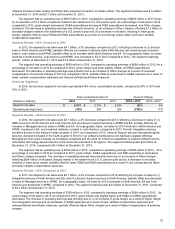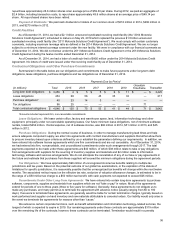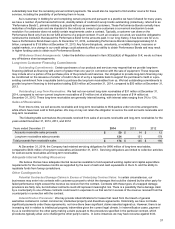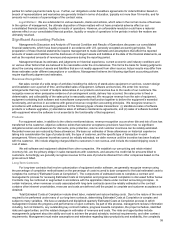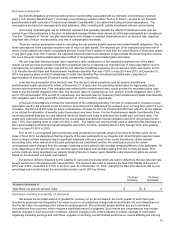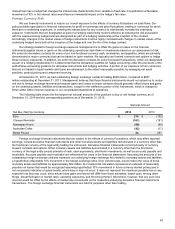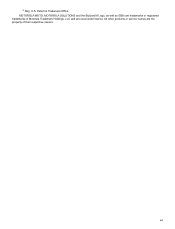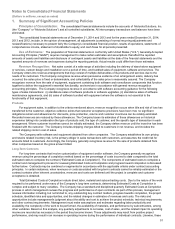Motorola 2014 Annual Report Download - page 44
Download and view the complete annual report
Please find page 44 of the 2014 Motorola annual report below. You can navigate through the pages in the report by either clicking on the pages listed below, or by using the keyword search tool below to find specific information within the annual report.42
value or composition of a reporting unit, or a sustained decrease in share price, among others. Any such adverse event or
change in circumstances could have a significant impact on the recoverability of goodwill and could have a material impact on
our consolidated financial statements.
The goodwill impairment assessment is performed at the reporting unit level. A reporting unit is an operating segment or
one level below an operating segment (referred to as a “component”). A component of an operating segment is a reporting unit if
the component constitutes a business for which discrete financial information is available and segment management regularly
reviews the operating results of that component. When two or more components of an operating segment have similar economic
characteristics, the components are aggregated and deemed a single reporting unit. An operating segment is deemed to be a
reporting unit if all of its components are similar, if none of its components is a reporting unit, or if the segment comprises only a
single component. Based on this guidance, we have determined that our Products and Services segments each meet the
definition of a reporting unit. We performed a qualitative assessment of goodwill and determined that it was not more-likely-than-
not that the fair value of each reporting unit was less than its carrying amount for the fiscal years 2014, 2013, and 2012. In
performing this qualitative assessment we assessed relevant events and circumstances including macroeconomic conditions,
industry and market conditions, cost factors, overall financial performance, changes in share price, and entity-specific events.
For fiscal years 2014, 2013, and 2012, we concluded it was more-likely-than-not that the fair value of each reporting unit
exceeded its carrying value. Therefore, the two-step goodwill impairment test was not required and there was no impairment of
goodwill. Therefore, the two-step goodwill impairment test was not required and there was no impairment of goodwill.
Recent Accounting Pronouncements
In May 2014, the FASB issued ASU No. 2014-09, "Revenue from Contracts with Customers." This new standard will
replace most existing revenue recognition guidance in U.S. GAAP. The core principle of the ASU is that an entity should
recognize revenue for the transfer of goods or services equal to the amount it expects to receive for those goods and services.
The ASU requires additional disclosure about the nature, amount, timing and uncertainty of revenue and cash flows arising from
customer contracts, including significant judgments and estimates and changes in those estimates. The ASU will be effective for
us beginning January 1, 2017, and allows for both retrospective and modified-retrospective methods of adoption. We are in the
process of determining the method of adoption we will elect and are currently assessing the impact of this ASU on our
consolidated financial statements and footnote disclosures.
Forward-Looking Statements
Except for historical matters, the matters discussed in this Form 10-K are forward-looking statements that involve risks and
uncertainties. Forward-looking statements include, but are not limited to, statements under the following headings:
(1) “Business,” about: (a) industry growth and demand, including opportunities resulting from such growth, (b) future product
development and the demand for new products, (c) customer spending, (d) the impact of our strategy and focus areas, (e) the
impact from the loss of key customers, (f) competitive position and our ability to maintain a leadership position in our core
products, (g) increased competition, (h) the impact of regulatory matters, (i) the impact from the allocation and regulation of
spectrum, particularly with respect to broadband spectrum, (j) the firmness of each segment's backlog, (k) the competitiveness of
the patent portfolio, (l) the impact of research and development (m) the availability of materials and components, energy supplies
and labor, and (n) the seasonality of the business,; (2) “Properties,” about the sufficiency of our manufacturing capacity and the
consequences of a disruption in manufacturing; (3) “Legal Proceedings,” about the ultimate disposition of pending legal matters
and timing; (4) “Management's Discussion and Analysis,” about: (a) market growth/contraction, demand, spending and resulting
opportunities, (b) the increase in public safety LTE revenues in 2015, (c) the decline in iDEN, (d) the return of capital to
shareholders through dividends and/or repurchasing shares, (e) the success of our business strategy and portfolio, (f) future
payments, charges, use of accruals and expected cost-saving and profitability benefits associated with our reorganization of
business programs and employee separation costs, (g) our ability and cost to repatriate funds, (h) the impact of the timing and
level of sales and the geographic location of such sales, (i) the impact of maintaining inventory, (j) future cash contributions to
pension plans or retiree health benefit plans, (k) the liquidity of our investments, (l) our ability and cost to access the capital
markets, (m) our ability to borrow and the amount available under our credit facilities, (n) our ability to retire outstanding debt,
(o) our ability and cost to obtain Performance Bonds, (p) adequacy of internal resources to fund expected working capital and
capital expenditure measurements, (q) expected payments pursuant to commitments under long-term agreements, (r) the ability
to meet minimum purchase obligations, (s) our ability to sell accounts receivable and the terms and amounts of such sales,
(t) the outcome and effect of ongoing and future legal proceedings, (u) the impact of recent accounting pronouncements on our
financial statements, (v) the impact of the loss of key customers, and (w) the expected effective tax rate and deductibility of
certain items; and (5) “Quantitative and Qualitative Disclosures about Market Risk,” about: (a) the impact of foreign currency
exchange risks, (b) future hedging activity and expectations of the Company, and (c) the ability of counterparties to financial
instruments to perform their obligations.
Some of the risk factors that affect our business and financial results are discussed in “Item 1A: Risk Factors.”
We wish to caution the reader that the risk factors discussed in “Item 1A: Risk Factors,” and those described
elsewhere in this report or in our other Securities and Exchange Commission filings, could cause our actual results to
differ materially from those stated in the forward-looking statements.
Item 7A. Quantitative and Qualitative Disclosures About Market Risk
Interest Rate Risk
As of December 31, 2014, we have $3.4 billion of long-term debt, including the current portion of long-term debt, which is
primarily priced at long-term, fixed interest rates. Of this total long-term debt amount, a $36 million Euro-denominated variable


